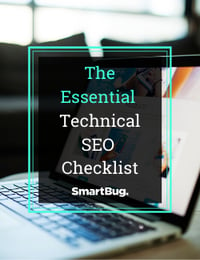
Just like in any industry or practice, there are a lot of terms and acronyms associated with SEO—and if you’re new to SEO, it can seem overwhelming. Never fear. You’re in the right place.
There are three things you should walk away with from this piece of content:
- A basic understanding of common terms and acronyms used in SEO
- A foundation for putting together a strong keyword and content strategy
- An understanding of the KPIs you need to determine if your keyword and content strategy is performing
Keyword Research
Keyword research is the process of gathering data and determining which words, queries, and phrases will help you not only rank well on search engine results pages but also draw qualified people to your site.
Keyword Research Practices to Follow
Quality Content
Producing quality content is the cornerstone of creating content that will rank well. Your keyword research should support this goal, not overshadow it.
Search Intent
Search intent is the searcher’s purpose when they enter a keyword into the search bar. The searcher could be researching more information on a topic, seeking to make a purchase, or simply looking to navigate back to a site they already visited. When selecting keywords for your content, keep search intent in mind. If the keyword you’ve selected isn’t going to meet the needs of your target audience, discard it and find another that will.
Keyword Search Volume
Keyword volume is exactly what it sounds like: the number of searches in a month a keyword receives. Broad terms, such as “best dog breeds,” receive larger keyword volumes. Long-tail keywords, such as “labrador retriever puppies near me,” receive smaller keyword volumes. Which you choose depends on the purpose of the content you’re creating. Are you seeking to drive more, less relevant traffic to your site? Or are you seeking to drive fewer, hyper-qualified visitors to your site?
Hot tip: A good content and keyword strategy involves striking the right balance.
Keyword Difficulty
Keyword difficulty is the measure of how difficult it will be to rank for a specific keyword. Many things come into play here, including how many of your competitors are already ranking for that keyword and the quality of the content from competing sites.
Keyword Practices to Avoid
Keyword Stuffing
Keyword stuffing is the practice of including so many keywords within a piece of content that it holds little to no value, resulting in a poor-quality piece of content that won’t rank and won’t reach your intended audience.
Keyword Cannibalization
Keyword cannibalization happens when you have multiple pages or blog posts on your site that target the same keyword. When this happens, search engines don’t know which piece of content to prioritize and will assign equal value to all pieces of content. This likely means each piece of content containing that keyword will rank poorly—or not at all.
On-Site Optimization
Alt Attribute or Alt Text
These tags are crucial for web accessibility. Screen readers will read an alt attribute, telling the user what the image is on their display. Alt text is the entered value of the alt attribute. It is a snippet of descriptive text about the image.
Alt text also offers search engine crawlers more information about what content is included in each image, helping them to rank images appropriately in image search results.
Anchor Text
Anchor text is the hyperlinked text that allows you to internally link to content within a website. Good anchor text is descriptive. If you’re using anchor text that doesn’t tell the end user much, like “read more” or “click here,” stop immediately and get more descriptive. For example, “Read our blog post about the 10 best dog breeds” clearly tells the reader where the link will take them.
Canonical URL
A canonical URL is a URL that helps your site avoid the appearance of duplicate content.
For example, this is useful if you’re publishing an article on your site and it appears in the blog section of your site. You’re likely going to have different pathways on your site leading to that piece of content. The visitor could access it in your blog sidebar or a “Featured Post” section on your homepage, or they could select the piece of content itself from the navigation on your site. These paths could result in a couple different URLs:
-
-
https://www.bestdogbreeds.com/blog/5-reasons-why-labs-are-the-best
-
https://www.bestdogbreeds.com/featured-blog/5-reasons-why-labs-are-the-best
-
A canonical URL on the piece of content will ensure that no matter how visitors reach that page, search engines are prioritizing the URL with the canonical tag:
- <link rel=”canonical” href=”https://www.bestdogbreeds.com/blog/5-reasons-why-labs-are-the-best/>
Duplicate Content
Duplicate content is content that exists in more than one place on your website or on a different domain. Duplicate content will affect the user experience of your site as well as how well your site ranks on search engines. Use a tool like SEMRush to identify and clean up duplicate content issues.
(And remember to ensure you’re using canonical URLs where appropriate.)
Title Tag
Title tags are crucial to your page’s ability to rank well organically on search engines. This HTML code tag gives your webpage a title. This title is what appears in search engine results and gives the searcher some information about what is included on the page.
Meta Description
A meta description is 160 characters of descriptive text that appears below the title tag in search results. Meta descriptions can be considered short pitches to users persuading them to visit a page. How is your page going to be of more use to the reader than the nine others listed in the results?
Technical Optimization
AMP
AMP stands for “accelerated mobile page.” As anyone who has tried to load a webpage on a mobile device knows, things move a bit more slowly on a phone than on a laptop. An AMP page is an HTML page designed specifically for fast loading.
Breadcrumbs
Hansel and Gretel’s “trail of breadcrumbs” is at least somewhat applicable here. Breadcrumbs are a secondary navigation method informing the website visitor where they are within the site structure of a website.
Core Web Vitals
Core web vitals are a set of three user experience metrics Google considers mission-critical. They are:
- Largest Contentful Paint (LCP): This vital indicates how quickly the main content of a page loads.
- First Input Delay (FID): This vital indicates how quickly the user can interact with the page.
- Cumulative Layout Shift (CLS): This vital indicates how visually stable the website is as it loads.
Sitemap
Sitemaps are crucial for empowering search engines to read, crawl, and index your site more efficiently. The more quickly your content is crawled and indexed, the more quickly search engines can rank it.
HTTPS
HTTPS stands for “Hypertext Transfer Protocol Secure.” Because it uses the Secure Socket Layer (SSL)/Transport Layer Security (TLS) protocol for encryption and authentication, it is the secure sibling to the HTTP protocol. HTTPS is crucial for sites processing payments and transmitting other sensitive data. HTTPS is also standard for ensuring your site ranks well in search engines.
Link Building and Authority
Domain Authority
In Moz’s words, “Domain Authority (DA) is a search engine ranking score developed by Moz that predicts how likely a website is to rank in search engine result pages (SERPs) ... Domain Authority is not a Google ranking factory and has no effect on the SERPs.”
Think of domain authority as similar to your site’s credibility score in comparison to competitor sites based on your site’s linking profile. You can use your DA score to determine how much more likely your site is to rank than competitor sites.
The more links your site has, the more established and authoritative your domain becomes, and the more likely it is to rank highly in search results.
Learn more about how to use domain authority correctly.
Link Building
Link building is a key part of driving organic traffic from search engines to your website. It is particularly powerful in competitive industries.
Link building is how you build your site’s domain authority. The practice of link building involves creating link-worthy content so that other sites link back to your site, using you as a resource to provide more value to their own visitors. This approach, paired with a link building strategy like the one outlined below, will help to build your authority and increase your chances of ranking well and getting more traffic from organic search.
Links, Inbound, Outbound, and External
Collecting inbound links to your site with a link building strategy is an intentional, time-consuming process. It involves:
- Creating phenomenal content and becoming a thought leader
- Making connections within your industry or space
- Conducting methodical outreach to relevant sites requesting backlinks to your content
(For one and two, think guest blogging, podcasting, webinar participation, event attendance, and so on.)
Because links back to your content provide additional user experience value to outside domains or pages, you’ll capture more outbound links.
Similarly, the outbound or external links you include in your content should provide relevant, additional value to the reader. Also, always remember to set those links to open in a new tab in order to keep visitors on your site.
For things to avoid in your link building strategy, read our blog post, “What Is Negative SEO?”
Keyword research tip: Your DA influences your keyword strategy. If your site has a high domain authority, it is typically easier to rank for higher-competition keywords. If your site has low domain authority, it is usually more difficult to rank for high-competition keywords.
Links, Internal
Internal links contribute to the site visitor’s navigational experience within the confines of your domain. Internal links should help the reader flow naturally through your content, providing more information or context where your audience typically has questions.
KPIs
Organic Traffic
Organic traffic is the traffic that is collected based on the appearance of your site in non-paid search results. Lots of things can influence your organic traffic.
These are a few things to keep in mind when you’re building your content plan and keyword strategy:
- How many keywords are you ranking for?
- How well are you ranking for those keywords?
- How much search volume do each of those keywords receive per month?
That being said, how can we tell if our content plan and keyword strategy are working?
Sessions
These are visits to your site from users who have found it through organic search results. Organic sessions are at the top of your marketing funnel. How many of them are you receiving per month?
Users
These are individuals who have visited your website. How many of them are new? How many of them are returning? The percentage of new users a month can tell you if your organic rank is improving or declining. The percentage of returning users can tell you how valuable your content is to your audience.
Time on Page
Moz defines time on page as, “Time on page is calculated by the time difference between the point when a person lands on a the page and when they move on to the next one.”
Similarly, time on page can indicate where your content and keyword strategy is hitting the mark and where you might be a bit off-center.
For example, if you have a page that lots of folks are visiting, but the time on page metric is 30 seconds, that is something you want to dig into. Either you’ve created the wrong keyword strategy for that page OR your content isn’t delivering what your site visitors are looking to find.
The Bottom Line: Conversions
The goal of every marketer is to drive more conversions. What are conversions?
MarketingSherpa’s glossary defines conversions as “the point at which a recipient of a marketing message performs a desired action.” So a conversion happens any time your desired audience responds to your call to action, such as “contact us,” “download,” or “watch.”
Conversions are measured by calculating a conversion rate. To determine your conversion rate, divide the number of completed “desired actions” (e.g., e-book downloads) by the number of visitors to that page.
The purpose of our content and keyword strategies is to drive more relevant traffic to our sites so we can increase our conversions and, ultimately, make more sales. HubSpot and Google Analytics tools can help you track the number of conversions sourced through an organic search. You can learn more about healthy organic conversion rates in our blog post “What Percentage of Organic Search Should Be Converting into Leads?”
If you’re driving lots of folks to your site and no one is converting, that’s a problem. It’s time to put on your thinking cap, dig into the data—and your new knowledge of SEO terms—and figure out what’s a bit off. Is it your keyword strategy? Your content creation? Your conversion rate optimization strategies utilizing on-page CTAs? Or, heck, maybe it’s your audience? In any case, it’s time for some sleuthing and experimenting. Personally, that’s my favorite thing about inbound marketing.

About the author
Melissa McGaughey Melissa McGaughey is a SmartBug Marketing Strategist equipped with a decade of B2B inbound marketing experience in a variety of industries, including retail, restaurant, SaaS, and IT. When she's not plugged in, you can find her painting her heart out, training for her next obstacle course race, or enjoying the ambiance of her favorite local coffee shop. Read more articles by Melissa McGaughey.





















